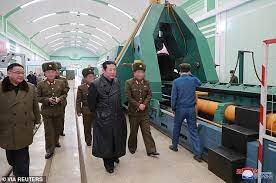North Korea flexes military muscle

Nuclear-armed North Korea has confirmed it has test-fired two more rounds of weapons this week saying the missile launches were successful.
According to North Korean media, the two latest “surface-to-surface tactical guided missiles” had been fired from a coastal area on Thursday and were armed with a conventional warhead.
North Korean Media say the missiles "precisely hit the target" and noted the "explosive power” of the conventional warhead, saying “the practical combat performance of the long-range cruise missile system would hold a reliable share in boosting the war deterrence of the country”.
KCNA also confirmed Tuesday's launches were two long-range cruise missiles that the North had first tested in September.
“The two missiles flew for more than two hours and 35 minutes and demonstrated an ability to strike targets 1,800 kilometers (1,118 miles) away, a performance that underscored their value in boosting the war deterrence of the country," the agency said.
Experts say the latest series of launches are the highest number of missiles test-fired by North Korea in a single month as Pyongyang begins 2022 with a rattling display of new and sophisticated weapons.
On Thursday, South Korea's Joint Chiefs of Staff said it had detected the launch of what Seoul said it presumed were two ballistic missiles from near Hamhung, on the east coast of North Korea. The Joint Chiefs of Staff said they had traveled for about 190 km and reached an altitude of 20 km.
The latest launches are the sixth round of tests the North has carried out this month and have drawn condemnation from the United States.
A few weeks ago, Pyongyang said it will be bolstering its defenses against the U.S. and consider resuming "all temporally-suspended activities", in what analysts have said is an apparent reference to a self-imposed moratorium on tests of nuclear weapons and long-range missiles.
Earlier in the month, North Korea tested tactical guided missiles, two "hypersonic missiles" capable of high speed and maneuvering after lift-off, and a railway-borne missile system.
Analysts have pointed out that some of the tests are aimed at developing new capabilities, for the most part, to evade missile defenses, while other tests are planned to give an idea of the preparedness and ability to adapt to different scenarios.
Analysts have also noted that the aim is to display some of Pyongyang’s missile forces that North Korea has already deployed.
Leader Kim Jong Un has called on the North Korean military to counter threats from the United States and its regional allies.
This week, state media said Kim had visited an unidentified "important" munitions factory, underscoring his vow not only to improve capabilities but mass-produce and deploy more weapons.
State media also says Kim has called on the military to boost the country's strategic military forces as he observed the test of a hypersonic missile, officially attending a missile launch for the first time in nearly two years.
The KCNA news agency reported that
after watching the test, Kim urged military scientists to "further accelerate the efforts to steadily build up the country's strategic military muscle both in quality and quantity and further modernize the army,".
Unlike some other recent tests, the ruling party’s newspaper Rodong Sinmun has published photos of Kim attending the launch on its front page.
Analysts say while Kim may have unofficially attended other tests, this appearance and its Page One feature on Rodong Sinmun means he is not concerned about being personally associated with tests of major new technology and does not care how Washington interprets this.
Many analysts say North Korea has every right to advance its military defensive capabilities just like any other country and that the heavy American military presence on its borders are the destabilizing factor.
So far this month, North Korea said it tested a new type of hypersonic missile on January 5 and again on January 11, with Kim Jong Unreported to have attended the second launch.
Hypersonic weapons usually fly towards targets at lower altitudes than ballistic missiles and can achieve more than five times the speed of sound - or about 6,200 km per hour.
Despite their name, analysts say the main feature of hypersonic weapons is not speeding but their maneuverability, which help evade missile defense systems.
On January 14 North Korea launched a pair of short-range ballistic missiles (SRBMs) from a train near the northern border with China, in what state media said was a short-notice drill aimed at boosting the proficiency of the troops operating the missiles.
North Korea first tested the rail-based system in September, saying it was designed as a potential counter-strike to any threatening forces.
According to analysts rail-mobile missiles are an efficient option to improve the survivability of nuclear forces, making it difficult for enemies to detect and destroy them before being fired,
Experts say the missiles appear to be KN-23 SRBMs, which were first tested in May 2019 and are designed to evade missile defenses by flying on a lower, "depressed" trajectory,
North Korea fired another pair of KN-23 missiles, this time from a wheeled launching vehicle.
State media said the tests confirmed the "explosive power" of its conventional warhead.
On January 17, North Korea launched two short-range ballistic missiles (SRBMs) in a rare test from an airport in its capital, Pyongyang.
According to state media, the pair of missiles "precisely hit an island target" off the east coast. Analysts said the missiles appeared to be KN-24 SRBMs which were last tested in March 2020 and appear to have entered mass production and deployment with military units.
Talks aimed at denuclearization have stalled after the United States wanted Pyongyang to abandon it nuclear and missiles program first in exchange for sanctions relief afterward. North Korea says it is open to diplomacy but only if the United States and its allies stop "hostile policies" such as sanctions or military drills.

Leave a Comment